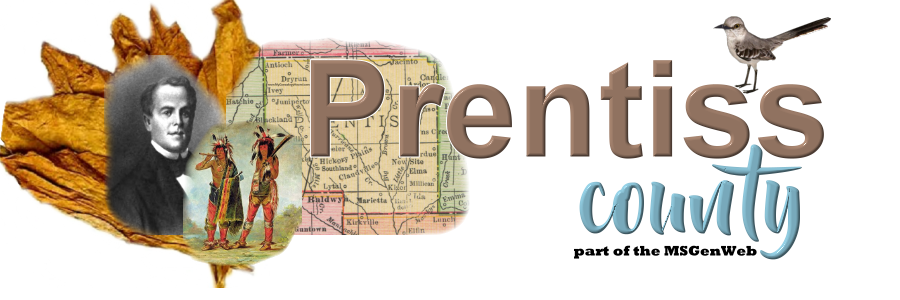| |
CARROLLVILLE COMMUNITY
(Taken from the Prentiss County History Book published in 1985 by
Curtis Publishing. This article written by Claude Gentry.)
Until 1870, Tishomingo County of Mississippi was the largest county in
the state, with Jacinto the county seat. During that year the county
was divided, forming the present Alcorn, Prentiss and Tishomingo
counties. Corinth, Booneville and Iuka were selected as county sites,
respectively.
Eastport, on the Tennessee River, some twenty miles to the northeast,
was the shipping center for river traffic, merchandise, and farm
produce for the northeast area of Mississippi, northwest Alabama, and
southwest Tennessee. Consequently, Carrollville was a very busy place
with in-going and out-going traffic to the river port and Jacinto.
In the 1830's the Chickasaw Indians ceded all of the "Happy Hunting"
grounds to the United States. This forced the Indians to move westward
to Indian Territory-now Oklahoma. Known as the "Trail of Tears", many
thousands of the helpless Indians died from starvation, disease and
freezing. This happened in 1833 until 1843, leaving a dark blot on the
history of the United States.
All traffic was moved over the road from Pontotoc to Eastport. Until
the Indians were moved, Pontotoc was the capital of the Chickasaw
nation.
This road from Pontotoc to Carrollville was known as the Wire Road due
to the fact that a telegraph line ran along it. In 1840 David Allen
and his wife Sally Spencer Allen left their home in Henry County,
Virginia, and headed southwest with their household effects,
livestock, and a few farm implements. They settled in the
almost-wilderness around Carrollville.
Carrollville grew into a sizable settlement, due mainly to the
location of it on the Pontotoc-Eastport route to the Tennessee River,
some 60 miles to the northeast.
The town of Carrollville produced some prominent citizens, who figured
in the progress of the newly admitted state of Mississippi to the
Union. The Civil War started in 1861. The Allens had six sons to serve
in the Confederate Army. One was killed, and five were wounded. John
M. Allen later known as Private John Allen, was to go on into national
prominence by serving 16 years in the United States Congress from the
first Congressional District of Mississippi. Col. W.H.H. Tison served
as speaker of the house in the Mississippi legislature.
The little town of Carrollville grew in size and influence. There were
two or three doctors, an inn, run by Wiley Belcher, two or three
saloons, two blacksmith shops, a tannery and a number of other
establishments. But the thriving little settlement was doomed to die
in the not too distant future.
It was only natural that the town should move to the railroad. People
began to move, and before long, only a few houses remained in the once
thriving community.
Today all that is left of the glory of the past is the boyhood home of
Private John Allen. It has been restored by Joe Horace Bishop, a
showplace to remind people of what existed long ago at Carrollville,
two miles northwest of downtown Baldwyn.
|

